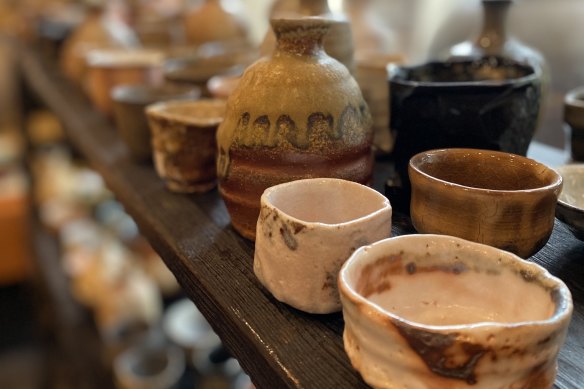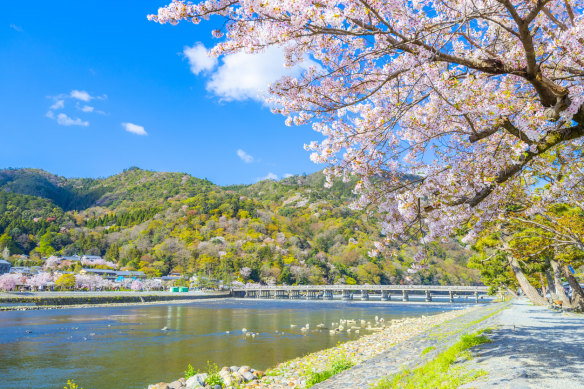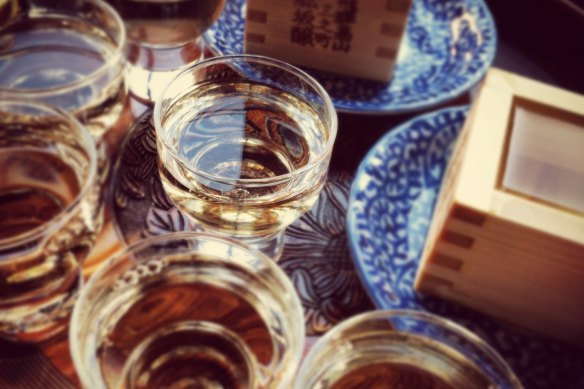Sipping the world’s oldest (and most expensive) sake
“It’s like holding a poem, like holding a haiku,” says Robert Yellin, his hands cupped around the small vessel, his eyes ablaze with passion. “It’s culture and history. It’s the basic elements of life: fire, water and earth.”
Yellin is talking about a cup, a sake cup, a piece of pottery moulded by an artisan’s practiced hands more than 400 years ago, and yet still very much a living thing, so beautiful and vital.
A cup is not just a cup. Certainly not to Yellin, an American expat whose love of Japanese ceramics drew him to Kyoto almost 40 years ago. Certainly not to true aficionados of sake, who understand that the vessel you drink from is as important as a wine glass, that it alters the flavour and the texture and the entire drinking experience.

A cup is not just a cup.: ceramic treasures at the Shuki Robert Yellin Gallery.Credit: Ben Groundwater
Yellin is a professional collector of pottery, but in particular of “shuki”, the cups from which sake is traditionally drunk. His eponymous gallery in the backstreets of Kyoto is more like a museum than a shop, with pieces sourced from across Japan and across history, linked by their beauty and the skill in their creation.
Those cups line the walls here and spill over onto the tatami-mat floors, all shapes and sizes, some perfectly round porcelain, others rough, irregular clay, some beautifully painted, others spattered with haphazard colour, perfect in their imperfection.
Yellin watches as you peruse the gallery to see what you’re drawn to. He comments on each cup you touch, gives you its history, explains its style. “This artist,” Yellin says as I hold a particular vessel, “says he wants every sip of sake to be like a first kiss.”
This is the initial step to understanding sake, a drink that’s so cherished and important in Japan, and yet can seem so opaque and unknowable to outsiders. The vessel matters. Everything, in fact, matters.
I’ve been drinking sake for a long time, and yet, still, it’s so foreign to me. The styles of sake, the flavours, even the labels, all of which tend to be traditional calligraphy, can be indecipherable to beginners. That’s why I’ve signed up for this day-long journey with Inside Japan into the heart of Kyoto’s sake-producing world.
And I didn’t come here just to stare at cups. I came here to drink from them. So our next destination is Matsui, a 300-year-old sake brewery in central Kyoto, just across the Kamo River from the Imperial Palace.

Blossom season at the Kamo River, near the Matsui brewery.Credit: iStock
The most important part of the tour at Matsui takes place at the bar near the entrance, where our group perches on stools and works our way through six tastings of Matsui’s key products.
Jorge Navarrete, yet another American expat drawn here by a love of local artistry, explains the difference between standard sake, in which the fermentation process is halted via pasteurisation, and “namazake”, or fresh sake, unpasteurised, in which the yeast cells are still alive.
“If you go to a bar here,” Jorge says, “always ask for namazake. That way you know what you’re getting will be local, and it will be created by proper artisans.”
With just a little more knowledge under our belts – and admittedly, some sake – we board a train heading south, to Fushimi. This is the true home of Kyoto’s sake-brewing culture, where 22 breweries thrive in centuries-old buildings.
One of the oldest of those belongs to Tsukino Katsura, a brewery that has been open since 1675, and has remained in the Masuda family that entire time. The smiling gentleman who meets us is Tokubei Masuda, the 14th generation at the helm.
He sits us at a bar and begins to pour tastings, multiple sake samples in short, round glasses.

Into the tasting, this is where everything begins to come together.
This is where everything begins to come together; the history of sake, the culture, the technique, the vessel.
Just as we’re about to leave, Masuda brings out something exceptional: a bottle of specially aged, 48-year-old sake, the absolute best of the best, a product that sells for 3 million yen (about $34,000) a bottle. He pours small samples of this deeply yellow, treacle-like liquid and we raise it to our lips to experience the wonder.
This, too, is like a poem, like a haiku. Only it’s one that was written almost 50 years ago, and is only just being read.
THE DETAILS
Visit
Inside Japan conducts bespoke tours in Kyoto, with itineraries focusing on sake conducted by local expert Van Milton. For prices and availability, see insidejapantours.com.
Stay
The Thousand Kyoto is a smart, stylish hotel just two minutes’ walk from Kyoto Station. Rooms start from $763 a night, see keihanhotels-resorts.co.jp
More
The writer was a guest of Kyoto City Tourism Association.
Sign up for the Traveller Deals newsletter
Get exclusive travel deals delivered straight to your inbox. Sign up now.